
Demographic features of the population of Hungary include population density, ethnicity, education level, health of the populace, economic status, religious affiliations and other aspects.
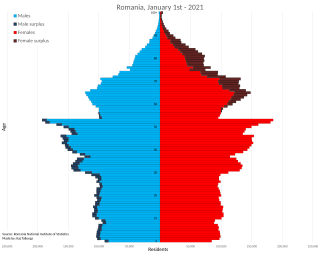
Demographic features of the population of Romania include population density, ethnicity, education level, health of the populace, economic status, religious affiliations, and other aspects of the population.

Bukovina is a historical region, variously described as part of either Central or Eastern Europe. The region is located on the northern slopes of the central Eastern Carpathians and the adjoining plains, today divided between Romania and Ukraine.

Brașov County is a county (județ) of Romania, in Transylvania. Its capital city is Brașov. The county incorporates within its boundaries most of the Medieval "lands" (țări) Burzenland and Făgăraș.

Sălaj County is a county (județ) of Romania, located in the north-west of the country, in the historical regions of Crișana and Transylvania. It is bordered to the north by Satu Mare and Maramureș counties, to the west and south-west by Bihor County, and to the south-east by Cluj County. Zalău is the county seat, as well as its largest city.

Sibiu County is a county of Romania, in the historical region of Transylvania. Its county seat is the namesake town of Sibiu.

Satu Mare County is a county (județ) of Romania, on the border with Hungary and Ukraine. The capital city is Satu Mare.

Mureș County is a county (județ) of Romania, in the historical region of Transylvania, with the administrative centre in Târgu Mureș. The county was established in 1968, after the administrative reorganization that re-introduced the historical judeţ (county) system, still used today. This reform eliminated the previous Mureș-Magyar Autonomous Region, which had been created in 1952 within the People's Republic of Romania. Mureș County has a vibrant multicultural fabric that includes Hungarian-speaking Székelys and Transylvanian Saxons, with a rich heritage of fortified churches and towns.
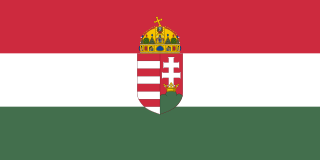
Northern Transylvania was the region of the Kingdom of Romania that during World War II, as a consequence of the August 1940 territorial agreement known as the Second Vienna Award, became part of the Kingdom of Hungary. With an area of 43,104 km2 (16,643 sq mi), the population was largely composed of both ethnic Romanians and Hungarians.
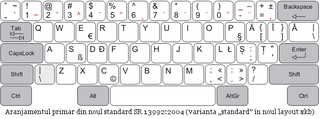
Beyond the official Romanian language, multiple other languages are spoken in Romania. Laws regarding the rights of minority languages are in place, and some of them have co-official status at a local level. Although having no native speakers, French language is also a historically important language in Romania, and the country is a member of the Organisation internationale de la Francophonie.
About 9.3% of Romania's population is represented by minorities, and 13% unknown or undisclosed according to 2021 census. The principal minorities in Romania are Hungarians and Romani people, with a declining German population and smaller numbers of Poles in Bukovina, Serbs, Croats, Slovaks and Banat Bulgarians, Ukrainians, Greeks, Jews, Turks and Tatars, Armenians, Russians, Afro-Romanians, and others.
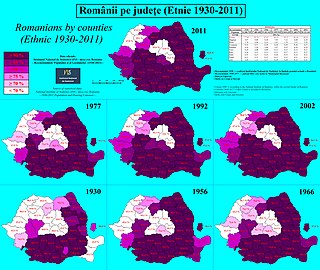
Romanianization is the series of policies aimed toward ethnic assimilation implemented by the Romanian authorities during the 20th and 21st century. The most noteworthy policies were those aimed at the Hungarian minority in Romania, Jews and as well the Ukrainian minority in Bukovina and Bessarabia.

The Germans of Romania represent one of the most significant historical ethnic minorities of Romania.

Poieni is a commune in Cluj County, Transylvania, Romania. It is composed of eight villages: Bologa (Sebesvár), Cerbești (Kecskéstanya), Hodișu (Hodosfalva), Lunca Vișagului (Viságmező), Morlaca (Marótlaka), Poieni, Tranișu (Tarányos), and Valea Drăganului (Nagysebes).
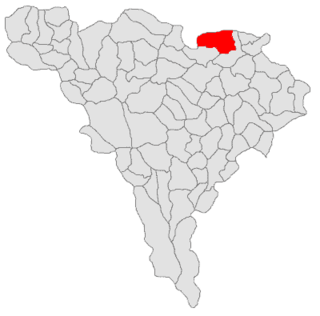
Unirea, previously Vințu de Sus, is a commune located in the north-east of Alba County, Transylvania, Romania. It is composed of six villages: Ciugudu de Jos (Alfüged), Ciugudu de Sus (Felfüged), Dumbrava (Dombró), Inoc (Inakfalva), Măhăceni (Aranyosmohács) and Unirea.

Zagon is a commune in Covasna County, Transylvania, Romania composed of two villages: Păpăuți (Papolc) and Zagon.
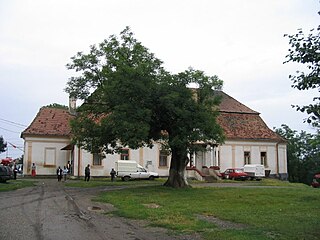
Voivodeni is a commune in Mureș County, Transylvania, Romania. It is composed of two villages, Toldal (Toldalag) and Voivodeni. The former village is much less populated than the latter.
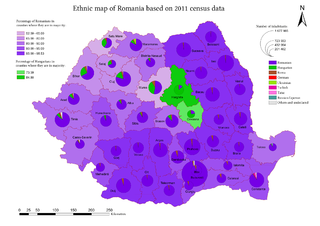
The Hungarian minority of Romania is the largest ethnic minority in Romania. As per the 2021 Romanian census, 1,002,151 people declared themselves Hungarian, while 1,038,806 people stated that Hungarian was their mother tongue.

Bobâlna is a commune in Cluj County, Transylvania, Romania, having a population of 1,888. It is composed of eleven villages: Antăș (Antos), Băbdiu (Zápróc), Blidărești (Tálosfalva), Bobâlna, Cremenea (Keménye), Maia (Mánya), Oșorhel (Erdővásárhely), Pruni (Nagymező), Răzbuneni (Radákszinye), Suarăș (Szóváros) and Vâlcelele (Bujdos). It is situated in the historical region of Transylvania.